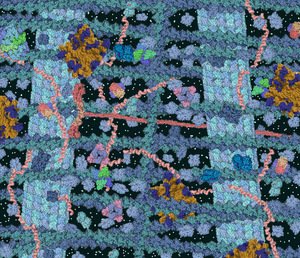
Back عصارة خلوية Arabic Цытазоль Byelorussian Цитозол Bulgarian সাইটোসল Bengali/Bangla Citosol BS Citosol Catalan سایتۆسۆل CKB Cytosol Czech Cytosol Welsh Cytosol Danish

| Cell biology | |
|---|---|
| Animal cell diagram | |
 Components of a typical animal cell:
|
The cytosol, also known as cytoplasmic matrix or groundplasm,[2] is one of the liquids found inside cells (intracellular fluid (ICF)).[3] It is separated into compartments by membranes. For example, the mitochondrial matrix separates the mitochondrion into many compartments.
In the eukaryotic cell, the cytosol is surrounded by the cell membrane and is part of the cytoplasm, which also comprises the mitochondria, plastids, and other organelles (but not their internal fluids and structures); the cell nucleus is separate. The cytosol is thus a liquid matrix around the organelles. In prokaryotes, most of the chemical reactions of metabolism take place in the cytosol, while a few take place in membranes or in the periplasmic space. In eukaryotes, while many metabolic pathways still occur in the cytosol, others take place within organelles.
The cytosol is a complex mixture of substances dissolved in water. Although water forms the large majority of the cytosol, its structure and properties within cells is not well understood. The concentrations of ions such as sodium and potassium in the cytosol are different to those in the extracellular fluid; these differences in ion levels are important in processes such as osmoregulation, cell signaling, and the generation of action potentials in excitable cells such as endocrine, nerve and muscle cells. The cytosol also contains large amounts of macromolecules, which can alter how molecules behave, through macromolecular crowding.
Although it was once thought to be a simple solution of molecules, the cytosol has multiple levels of organization. These include concentration gradients of small molecules such as calcium, large complexes of enzymes that act together and take part in metabolic pathways, and protein complexes such as proteasomes and carboxysomes that enclose and separate parts of the cytosol.
- ^ Cite error: The named reference
Elliswas invoked but never defined (see the help page). - ^ Cammack, Richard; Atwood, Teresa; Campbell, Peter; Parish, Howard; Smith, Anthony; Vella, Frank; Stirling, John (2006). Cammack, Richard; Atwood, Teresa; Campbell, Peter; Parish, Howard; Smith, Anthony; Vella, Frank; Stirling, John (eds.). "Cytoplasmic matrix". Oxford Dictionary of Biochemistry and Molecular Biology. Oxford University Press. doi:10.1093/acref/9780198529170.001.0001. ISBN 9780198529170.
- ^ Liachovitzky, Carlos (2015). "Human Anatomy and Physiology Preparatory Course" (pdf). Open Educational Resources. CUNY Academic Works: 69. Archived from the original on 2017-08-23. Retrieved 2021-06-22.
© MMXXIII Rich X Search. We shall prevail. All rights reserved. Rich X Search